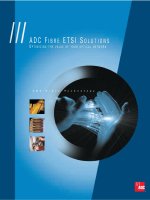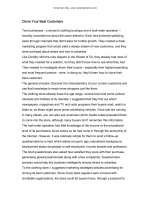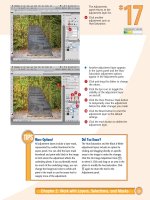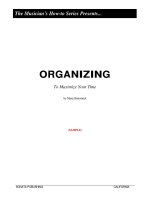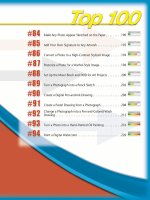Prepare your money plan_6 pptx
Bạn đang xem bản rút gọn của tài liệu. Xem và tải ngay bản đầy đủ của tài liệu tại đây (336.48 KB, 21 trang )
ptg
them. By federal law, you’re liable for $50, but all the
major credit card companies limit your liability to zero.
Of course, these protections apply whether you’re
shopping online or in a real store. But online you have
a greater chance of dealing with an unfamiliar retailer.
Credit cards are a buffer between you and a strange
merchant.
For more about credit cards, see Chapter 6, “Credit
When Credit’s Due.”
One exception to this rule is if you don’t own a
credit card and don’t want to. Maybe you’ve gotten into
trouble before running up balances you had trouble
paying off. In that case, you’re left with using your debit
card that acts as a Visa or MasterCard.
Other intermediary forms of online payment, such as
PayPal and Google Checkout, can link to credit cards
and bank accounts. But they’re not widely available as
payment options.
129
How to Buy Stuff
QUICK TIP
Get an autofill program. These little computer pro-
grams will fill in your name and address information
and some even store your credit card information, so
you don’t have to fetch your card each time you buy
something online. Just as valuable, these programs
automatically fill in your logins and passwords to all
the different retailers you buy from. There are some
free autofill programs available, often as plug-ins for
Web browsers, such as Google Toolbar,
toolbar.google.com. I shop online so often, I bought
a robust form filler called RoboForm Pro,
www.roboform.com (Windows only).
From the Library of Wow! eBook
ptg
130
The 1-2-3 Money Plan
Coupon Codes and Rebate Portals
Consider these two shopping scenarios that
illustrate ways to save money while shopping
online.
Coupon Codes
Imagine standing at a store checkout. To get 10
percent off your order, all you would have to do
is step away from the cashier for a moment and
look on a nearby shelf for a coupon. Would you
bother?
That’s essentially what you can do while shop-
ping on the Internet. Get in the habit of search-
ing for discount codes, also called promotional
codes or coupons.
When buying online, you place items in a virtual
shopping cart and then go through a checkout
procedure. While checking out, the Web site
often will ask if you have a discount code to
enter. These codes are generally a series of num-
bers and letters that unlock goodies, such as a
percentage discount on your order, dollars off
your purchase, and discounted or free shipping.
If you don’t have a discount code, don’t just
ignore the promotional code box. Go code
hunting.
Open a separate window in your Web browser.
Call up a few of your favorite Web search engines
to find codes. Type in the retailer’s name, the
From the Library of Wow! eBook
ptg
131
How to Buy Stuff
word “code” and other terms such as “promo-
tional,” “coupon,” and “discount.” You can also
try code aggregators, such as CouponMom.com,
CouponCabin.com, FlamingoWorld.com, and
CouponMountain.com. If you find a code, return
to your checkout browser and type or paste the
found promotional code into the box. The code
might have expired, but there’s no harm in trying
it. The worst that happens is the retailer rejects
the code. If you type in a correct code, the dis-
count will be applied to your order.
A few minutes of searching could yield worth-
while savings, such as 10 percent off, free ship-
ping, or $15 off an order, for example.
Rebate Portals
Imagine you’re standing at the threshold of a
retail store, but you can get a 10 percent dis-
count if you walk through another entry door.
Would you do it?
That’s what you can do by shopping through
rebate portals.
A shopping portal, or entrance, is a separate
free Web site that has an arrangement with
retailers. Retailers pay a commission to portal
operators in return for sending Internet con-
sumer traffic to the retailer’s site—a kind of
referral fee. When the consumer makes a pur-
chase, the retailer pays the portal a commis-
sion. A “rebate” shopping portal goes a step
From the Library of Wow! eBook
ptg
132
The 1-2-3 Money Plan
further and shares its commission with the
consumer.
To use a rebate portal, sign up for free at the
portal’s site. Then, instead of making a pur-
chase directly at a retailer’s Web site, go to the
portal to see whether it is affiliated with that
retailer. If so, click the link to enter the retailer
through a side door, of sorts. Then, proceed
through the online checkout as you normally
would.
Behind the scenes, the retailer knows the portal
sent you. It pays a commission to the portal.
Then the portal shares the commission with you
by crediting your portal rebate account. It’s all
electronic and automatic, akin to a rewards
credit card.
A typical rebate to you would be about 5 per-
cent of the purchase price, but it can vary
widely, even surpassing 10 percent for some
retailers. Opt for cash rebates instead of points
or other rewards.
Popular rewards sites include FatWallet.com,
Ebates.com, Jellyfish.com, and QuickRewards.
net. Portals that donate your rewards to college
savings plans include Upromise.com, BabyMint.
com, and LittleGrad.com. If you’re having trouble
choosing, go with Ebates.com. Learn more at
CompareRewards.com.
From the Library of Wow! eBook
ptg
133
How to Buy Stuff
Fun Tangent: Eyeglasses Online
You can buy almost anything online nowadays.
One of my favorites is eyeglasses. Weird, right?
The short story is my first pair of glasses pur-
chased online cost me $8. Actually, with ship-
ping and a clip-on sun shade, they cost $16.90
delivered. I see great with them and they look
good too. In fact, it’s a toss-up which I like
more, these glasses or the ones I paid about
$300 for from a chain-store optician.
I ordered them from ZenniOptical.com.
Granted, there are no frills with ordering glasses
this way. They arrived in seven business days in a
padded envelope in a simple hard-plastic case.
There are a few minor drawbacks:
1. My written prescription from my eye doctor
did not include a measurement for PD,
pupillary distance, which is basically the
distance in millimeters between the centers
of your eyeballs. You need this measure-
ment to order online. I measured my PD in
a mirror. I’m sure that’s not the way the eye
doctor would recommend, but it seems to
have worked.
2. You might have to have the nose pads and
arms of the glasses adjusted if they don’t sit
right on your face. This might cost you a
few bucks, but many optometrists will do it
for free.
From the Library of Wow! eBook
ptg
How to Buy Used Stuff
Buying used stuff can elicit extreme opinions, usually
from people who rarely, if ever, buy anything second-
hand. But buying every item in your life as new just isn’t
being smart with money.
Maybe nowhere is the argument for buying used
items more persuasive than in buying cars. New cars
can lose 30 percent of their value in the first year of
134
The 1-2-3 Money Plan
3. The clip-on sun shade isn’t custom-made
for the glasses, but it fits and covers the
lenses well.
The cheap glasses have thinner metal and might
not last as long. However, doing the math, I can
buy 16 pairs of ZenniOptical glasses for the
price of one discounted pair at a popular
retailer. At these prices, you can own several dif-
ferent styles of eyeglasses for a fraction of the
usual retail price.
I was so pleased I followed up by ordering rim-
less bifocals with every option available, includ-
ing antireflective coating. That surely would
have cost $500 at an optician or eye doctor. My
cost: $68. My 10-year-old son now refuses to
wear his $300 eyeglasses, and insists on wearing
his $8 Zennis. He says he just likes them better.
Go figure.
By the way, a different Web site, EyeBuyDirect.
com, also sells eyeglasses for about $8.
From the Library of Wow! eBook
ptg
ownership. So, if you’re talking about a $30,000 vehi-
cle, the difference between a new car and 1-year-old car
is $9,000. If $9,000 is a lot of money in your world, this
discussion about buying used stuff is for you.
135
How to Buy Stuff
How to Buy Used Stuff, 1-2-3
1. Get over the “yuck” factor.
2. Evaluate price and quality.
3. Keep it simple.
1. Get Over the “Yuck” Factor
The first step in saving money with used items is to
break through a mental barrier. It might not be pleasant
to read it in black and white, but some people think
used merchandise is:
• Broken/tattered
• Dirty/smelly
• Not worth my time/Only for poor people
So, I’m here to tell you that buying something used
doesn’t make you an inferior person. I don’t think of
myself as generally inferior, and I’m not poor. But I reg-
ularly stop by a local consignment shop to see what
men’s clothing they have. I bought a suit for $25 that I
wear during television appearances. I bought a pullover
windbreaker for $2. I splurged on two pricey silk neck-
ties, $8 each.
How do you get over a mental barrier about buying
used? Just do it.
From the Library of Wow! eBook
ptg
This is another of the rare occasions where I advise
you to spend money to save money. Go to a local thrift
store or consignment shop and buy a used piece of
clothing that you will wear, even if it’s only a scarf or
belt. Alternatively, buy a set of drinking glasses or
plates. The point is to buy something used that you have
a very personal interaction with. This way, you can con-
front your fears about buying used merchandise. If you
have a pleasant experience, your aversion to buying
used stuff will dissipate, if not disappear. You will get
over the “yuck” factor.
Then a whole new world of retail opens up to you.
You can consider used items from eBay.com,
Craigslist.com, Freecycle.org, garage sales, flea markets,
thrift stores, and newspaper classified ads.
136
The 1-2-3 Money Plan
QUICK TIP
Add to your barrier-breaking errands a stop by a local
dollar store. The merchandise isn’t used, but it is
cheap. Dollar stores can be ideal outlets for junk
food, such as cookies, pretzels, and chips. I’ve bought
such things as an iPod case, calculator, greeting cards,
and printer USB cord at a dollar store. Just avoid
cheap electric or electronic items for fear of a fire
hazard.
From the Library of Wow! eBook
ptg
2. Evaluate Price and Quality
Buying something used might mean settling for a prod-
uct of lower quality than you can get new. That’s fine
for many purchases. Nobody can reasonably expect to
buy the best of everything.
On the other hand, buying used might mean you can
afford something of higher quality. If you have $500 to
spend on a living room sofa, which do you think is
higher quality: a new one from Ikea or an Ethan Allen
model purchased used? So buying used sometimes
means you can get a superior product.
Similarly, buying used might get you a luxury brand
with more features. Go back to the automobile exam-
ple. Would you rather have a 2009 Chevrolet Cobalt
subcompact or a 2-year-old Honda Accord? Or, for that
matter, a 2003 Lexus ES 300 or BMW 3 Series? They all
cost the same.
But, it’s true, buying used items can be more of a has-
sle than buying new. So, it’s always important to evalu-
ate prices and quality.
3. Keep It Simple
Some items are not functionally different whether new
or used, assuming they are undamaged. These include
movie DVDs, music CDs, video games, and, yes, even
books like this one. A simple garden shovel or hammer
is preferable to buy used, rather than a rototiller or cir-
cular saw. The simpler, the better—fewer things to go
wrong.
Other examples of great used purchases include kids
clothing, toys, and musical instruments—considering
137
How to Buy Stuff
From the Library of Wow! eBook
ptg
they might be used for a short time. Consider simple
sports equipment, such as golf clubs, assuming you’re
not worried about custom fitting.
Of course, automobiles don’t exactly fit into the cat-
egory of a “simple” machine. But cars are so reliable
nowadays. Many go 150,000 miles with only routine
maintenance. So a corollary of the “simple” rule is to
favor used items when they’re reliable.
138
The 1-2-3 Money Plan
QUICK TIP
An often overlooked source of free used items is your
local public library. Besides books, many have a wide
variety of periodicals, movie videos, and music CDs.
Refurbished Electronics
One way to purchase electronics cheaper is to
buy them as “refurbished.” Contrary to its
name, refurbished often does not mean the
item is used, repaired, or inferior in quality. In
fact, it might undergo tighter quality control
than a new item because someone has checked
to make sure the machine works.
The reason an item is classified as a “refurb”
could be minor, such as marred packaging. Or,
maybe a previous customer bought the item but
returned it because he didn’t like the color or
couldn’t figure out how to use it.
From the Library of Wow! eBook
ptg
139
How to Buy Stuff
Consumer savings from buying refurbs can be
significant, 10 percent to 50 percent off retail
price.
I’ve done even better than that. I bought a refur-
bished universal remote control that operates a
TV and several related components. It’s a fancy
remote—definitely falls in the “wants” category.
It typically costs about $150. I got a refurbished
one for $80. Works great. The only difference is
the refurbished remote came in plain packaging
instead of the colorful blister-pack the new item
comes in.
However, before buying a refurb, investigate
how the retailer defines “refurbished.” And find
out about the return policy and what warranty
you’ll get.
The safest place to buy a refurb is from a man-
ufacturer. Such major makers as Dell, Apple,
HP, Sony, and Epson sell their own refurbished
electronics. The easiest way to search for and
buy refurbs is online, often at a manufacturer’s
own site. Some third-party online retailers, such
as TigerDirect.com and NewEgg.com, also do a
robust refurb business. Major retailer Target
has started selling “pre-owned electronics,” and
Amazon.com sells refurbs at a companion Web
site, Warehousedeals.com.
From the Library of Wow! eBook
ptg
How to Teach Kids about Money
Teaching children to be good spenders and savers is a
topic that can befuddle even the most well-intentioned
and well-informed parents. The main tool is an
allowance system, which can teach skills kids will use
for the rest of their lives.
As those children mature into adults, they will have
to resist almost constant marketing pitches from adver-
tisers on TV, Web sites, billboards, magazines, and
newspapers. And they’ll probably have credit available
to them, allowing them to buy even when they can’t
afford it.
Money troubles await children who don’t learn that
money is finite, and they have to make trade-off deci-
sions with purchases. They’ll have to distinguish
between needs and wants.
140
The 1-2-3 Money Plan
How to Teach Kids about Money, 1-2-3
1. Give children an allowance.
2. Don’t tie allowance to chores.
3. Make rules.
1. Give Children an Allowance
Customize allowance amounts to what you can afford
and what you think your child can handle. But don’t
give too little. The child needs to be able to save enough
money in a relatively short period to buy something he
or she wants.
From the Library of Wow! eBook
ptg
A suggestion: Beginning around the ages of 5 to 7,
give 50 cents per week for each year old the child is. At
age 10, give $1 per year old. A less-accelerated plan is
$1 weekly for each school grade level.
2. Don’t Tie Allowance to Chores
Don’t confuse money lessons. Learning how to spend
smart as a consumer is a different lesson than “you have
to work for a living.” You are not paying your children
a salary; you’re giving them money as a tool for learn-
ing, like you would give them a piano to practice on or
flash cards with which to memorize multiplication
tables.
So don’t tie allowance to chores. Chores are to be
done by the child for free because he or she is part of the
household and has a responsibility to help operate it. If
a child decides she doesn’t feel like doing chores and
will forgo the allowance, the allowance system crumbles
and the lessons are lost. How will you respond when
you tell her to make her bed and she asks, “How much
are you going to pay me?”
To instill a work ethic and entrepreneurial spirit,
offer a list of optional jobs a child can choose to com-
plete for extra money.
If you disagree with this philosophy, go ahead and
tie allowance to chores—after all, you’re the parent. But
regularly talk to the child about both lessons—spending
and earning—separately.
141
How to Buy Stuff
From the Library of Wow! eBook
ptg
3. Make Rules
Require the child to earmark money each pay period for
three accounts: spending, saving, and giving. For
younger children, it’s easy to place equal amounts into
three containers or envelopes, labeled with each cate-
gory. Identify types of purchases the child will be
responsible for. Don’t give loans or advances.
The “spending” account is where all the action is,
and some of the best lessons. Money in this account
should be spent regularly.
Allow children to make mistakes with this money.
You want them to buy things impulsively that they later
regret. You want them to buy a poor-quality item that
breaks. You want them to run out of money, forcing
them to save for several weeks to buy the next thing.
You want them to choose among similar items with dif-
ferent prices.
Children need the repetition of buying things and
witnessing the consequences of the decisions. Of course,
parents should retain veto power over types of pur-
chases, such as candy or dangerous toys.
Regularly talking to children after money decisions,
especially poor spending decisions, is crucial. Talk about
your own money life, too, such as why you’re using
coupons at the supermarket and how credit cards work.
With the “saving” account, the point is to show how
money adds up over time. This money is not to be spent
but to be counted and monitored. When you dismantle
the allowance system in the child’s late teens, the money
can be used for college expenses or a car, for example.
142
The 1-2-3 Money Plan
From the Library of Wow! eBook
ptg
Earmarking money for “giving”—weekly church
donations or periodic donations to a charity—provides
a deeper lesson about what money can be used for.
Of course, you can adjust the allowance plan to fit
lessons you are trying to teach. Here are examples:
• Include lunch money in older children’s allowance
and offer a deal: The children can keep the lunch
money for each day they make a lunch at home
and brown-bag it.
• Switch to a monthly allowance for older children,
forcing them to budget their money over a longer
period.
• Make saving optional but offer to match the
child’s contribution to their savings dollar for
dollar.
Details of an allowance system aren’t as important as
making the effort to start one, adjusting it over time and
teaching the lessons.
143
How to Buy Stuff
From the Library of Wow! eBook
ptg
This page intentionally left blank
From the Library of Wow! eBook
ptg
B
y now, we all know the “inconvenient truth”—
the Earth’s environment is endangered. But here’s
a convenient truth: You can help Mother Earth
while saving money.
Links between environmentalism and spending
smart are undeniable. You don’t have to look hard to
see that going green means more green in your neigh-
borhood and in your wallet. It’s a realization corporate
America is just now waking up to. Such terms as sus-
tainability and carbon footprint have entered the board-
room lexicon.
For consumers, the primary misconception is that
making an environmental effort will cost you money or
convenience. That can be true in some cases. But today,
there are many examples of how you can save green
while going green.
This chapter gives just a few examples of the easiest
and most worthwhile steps to take.
145
Chapter 5
Green Means Green
From the Library of Wow! eBook
ptg
Gasoline
No other price fires up Americans more than gasoline
prices. Maybe it’s because we have no control over
prices and feel helpless. Maybe it’s because it’s a neces-
sary expense, especially in suburban and rural areas. Or
maybe it’s because we see the prices flaunted in huge
numbers at every commercial traffic intersection.
Whatever the reason, you can probably spend less on
gas. That not only puts more money back in your
pocket but helps the environment and America’s
dependence on foreign oil.
146
The 1-2-3 Money Plan
Gasoline, 1-2-3
1. Don’t spill the coffee.
2. Take it slow and steady.
3. Pump it up.
A discussion about saving on gas centers on two
main areas: What you drive and how you drive.
Let’s start with what you drive.
Many people think they can fix their gas-spending
problem by trading in their gas-guzzler for a new fuel-
efficient car. That’s often false. The reason? Hidden
costs.
We won’t get into all the math here, but depreciation
of a new vehicle and the cost of financing that vehicle
often far surpasses any gasoline savings you’ll reap. So,
unless you’re accounting for those hidden costs, you
can’t accurately assess the value of swapping vehicles.
From the Library of Wow! eBook
ptg
Other hidden costs include higher insurance rates for
a newer car and sales tax that you’ll have to pay if you
live in a state that levies sales tax. Let’s look at sales tax
alone. At 6 percent, you’ll pay $1,500 in sales tax to
buy a $25,000 vehicle. $1,500 buys a lot of gas for your
gas-guzzler.
Now, if you were going to replace your current vehi-
cle anyway, it makes sense to buy a fuel-efficient one. Of
course, the best idea is to buy a late-model used car,
which allows someone else to take the tremendous first-
year depreciation hit of a new car.
So, for saving money on gasoline, that leaves us with
how you drive.
1. Don’t Spill the Coffee
While driving, imagine you have a cup of coffee, uncov-
ered, in your cup holder. You don’t want that coffee to
slosh out of the cup and onto you or the car floor. So,
what do you do? You try to drive as smoothly as possi-
ble, with gradual acceleration, more coasting, and grad-
ual braking. If you’re accustomed to being aggressive
with the accelerator and brake pedals, this tip will
improve your gas mileage considerably, making your
gas dollars go further.
When automotive Web site Edmunds.com set out to
prove which gas-savings tips saved the most money,
they found aggressive driving was the number one
money drain. Moderating your driving habits with
slower acceleration and braking saved up to 37 percent
on gas, with the average savings at 31 percent. Could
you imagine saving one-third of the money you spend
147
Green Means Green
From the Library of Wow! eBook
ptg
annually on gasoline? If you normally spend $50 a week
to put gas in your car, that’s a savings of $858 a year.
Two cars? That’s more than $1,700 saved.
Smooth acceleration, cornering, and braking extend
the life of the engine, transmission, brakes, and tires,
too, saving even more money.
2. Take It Slow and Steady
Here’s another visualization that might work. Imagine
that as you press down on the accelerator pedal, money
leaks from your wallet. The harder you press, the more
money leaks out. It’s like at the gas station when you
begin fueling up your vehicle: The tighter you squeeze
the trigger of the fuel pump, the faster the price-readout
advances.
The point is to drive slower.
Consumer Reports tested a Toyota Camry. By
increasing the highway cruising speed from 55 mph to
65, the car’s fuel economy dropped from 40 miles per
gallon to 35. Speeding up to 75 mph cost the car
another 5 mpg. One reason, Consumer Reports says, is
that aerodynamic drag increases exponentially the
faster you drive. It simply takes more fuel to power the
car through the air.
And use cruise control when you can, even on sub-
urban roads at 40 mph. It’s a surprisingly effective way
to save gas, up to 14 percent, Edmunds.com found.
Cruise control smoothes out the driver’s accelerator use,
preventing surges. It also makes the driver take the long
view of the road, rather than reacting to every change in
traffic around them.
148
The 1-2-3 Money Plan
From the Library of Wow! eBook
ptg
3. Pump It Up
OK, I’ll concede that keeping your car tires properly
inflated is a common tip and it won’t save you tons of
money or gasoline. But it’s so cheap and easy.
Consumer Reports found a Toyota Camry experi-
enced a 1.3 mpg loss in highway fuel economy when
tires were underinflated by 10 pounds per square inch
(psi). Maybe more important, underinflated tires com-
promise handling and braking and wear faster.
Underinflated tires also run much hotter, which can lead
to tire failure.
Check the pressure of your vehicle’s tires at least
once a month with a tire gauge. The correct pressure
usually can be found on a label in your vehicle’s driver-
side door jamb. Of course, you’ll want to keep an eye
out for a service station that doesn’t charge for using its
tire pump.
149
Green Means Green
Gasoline Myths
Some bad information gets passed around
about saving money on gas. Here are a few
examples:
● Air conditioning versus open windows.
This has been a long-running debate, but
the short answer is there’s no significant
difference in fuel economy. Do whatever
makes you more comfortable.
● Additives and devices. Don’t bother with
fuel-tank additives and devices that attach
From the Library of Wow! eBook

